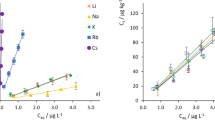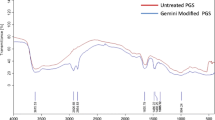Abstract
The surfactant-modified bentonite has been focused on the adsorption of hydrophobic organic contaminants in aqueous solutions, because the surfactant (e.g. quaternary alkylammonium salt) intercalation leads to the formation of highly hydrophobic domains. Humic substances (HSs) can serve as naturally occurring surfactants of higher affinity to hydrophobic organic contaminants, such as pentachlorophenol (PCP). However, HSs cannot be loaded into interlayer of montmorillonite in bentonite (Bent) because of their larger size. In the present study, the humin-like substance (HuLS) was loaded to the montmorillonite interlayer via polycondensation reactions of glycine and catechol as humic precursors. The montmorillonite basal spacing was expanded by forming the HuLS-bentonite complex (HuLS-Bent), showing the intercalation. The Freundlich adsorption coefficients of PCP for HuLS-Bent and Bent (K f) were evaluated at pH 4.0, 5.5 and 6.5. While K f values decreased with an increase in pH, K f values for the HuLS-Bent (83–1,220) were larger than the reported values for other organically modified clays (19–100 at pH 3–6). These results suggest that the prepared HuLS-Bent is effective in the removal of PCP from water.
Access provided by Autonomous University of Puebla. Download conference paper PDF
Similar content being viewed by others
Keywords
Introduction
Adsorbents for preventing pentachlorophenol (PCP) leaching from the contaminated sites and for removing PCP from contaminated waters have been highlighted. Montmorillonite is known to be one of the main minerals in bentonite (Bent) indicating interlayer structure and surfactant-intercalated montmorillonites can effectively adsorb PCP from water (Bouras et al. 2010). On the other hand, humic substances (HSs) are naturally occurring surface-active materials that show amphiphilic nature for both hydrophilic and hydrophobic properties. Such functions of HSs can serve as sorption of hydrophobic organic contaminants, such as PCP, to soil particles (Paolis and Kukkonen 1997). Affinity to hydrophobic organic contaminants for clay minerals can be enhanced when complexing with HSs. Thus, humic-clay complexes may be regarded as effective and non-toxic adsorbents. The hydrodynamic radii of HSs have been reported to be in the range of 22–71 Å (Kawahigashi et al. 2005). Thus, naturally occurring HSs are difficult to intercalate into the interlayer, because of the smaller spacing for the montmorillonite interlayer (approximately 10–20 Å). Bent can catalyze the formation of dark-coloured polymers like HSs from humic precursors, including amino acids and phenols (Miura et al. 2009). Humic precursors, such as phenols and amino acids, can be intercalated into the montmorillonite layer, and humin-like substances (HuLS) can be formed in the interlayer via their polycondensation reactions. In the present study, the HuLS-Bent complex was prepared via polycondensation reactions of catechol and glycine in the presence of Bent. In addition, relations between surface properties and adsorption behaviours of PCP for the prepared HuLS-Bent were compared with those for a non-modified Bent.
Materials and Methods
Two grams of the powdered Bent was placed in a 300-mL Erlenmeyer flask and a 150-mL aliquot of an aqueous solution containing catechol and glycine (0.01 M each) was then added. The mixture was shaken at 160 rpm for 2 weeks, and the temperature was maintained at 30°C. The pH of the solution was daily adjusted to 7.00 ± 0.5 using aqueous 0.1 M HCl and 0.1 M NaOH solutions. After 2-week incubation, the reaction mixture was centrifuged at 10,000 rpm for 15 min. The solid was washed with water and then freeze-dried to give a powdered sample of HuLS-Bent. The powdered samples for Bent and HuLS were characterized by XRD and zeta potential analyses.
A stock solution of PCP (1 mM) was prepared by dissolving it in 0.2 M KOH aqueous. This was diluted to appropriate concentrations with 0.1 M KCl aqueous, and the pH values of these solutions were adjusted to 4.0, 5.5 or 6.5 with aqueous solutions of KOH and HCl (solution A). The Bent or HuLS-Bent suspension in 0.1 M KCl aqueous (8 mg mL−1) was prepared by adjusting pH to 4.0, 5.5 or 6.5 using a DKK-TOA AUT-501 auto-titration system (solution B). The 0.4 mL of solution A, 1.25 mL of solution B and 0.35 mL of the 0.1 M KCl aqueous that pH was adjusted were mixed in the 10-mL glass tube. The glass tube was shaken at 170 rpm and 25°C for 24 h. The mixture was then centrifuged for 10 min at 3,000 rpm, and PCP in the supernatant was analyzed by HPLC. The adsorption of PCP can be interpreted using the following Freundlich-type isotherm equation:
where q s, K f, C e and n denote the concentration of adsorbed PCP to the adsorbent (μmol kg−1), the Freundlich adsorption coefficient (μmol kg−1 μM−n), the equilibrium concentration of PCP remained in the aqueous solution and the exponential empirical parameter that accounts for the non-linearity in the adsorption behaviour, respectively.
Results and Discussion
Figure 1 shows the XRD patterns for Bent and HuLS-Bent. Montmorillonite was a major mineral component in the Bent, while a few silicate peaks, cristobalite and quartz, were found as concomitants. Because the basal spacing can be increased by the intercalation of water with increasing relative humidity, XRD patterns for Bent and HuLS-Bent samples were recorded by eliminating water using the relative humidity control system for XRD (Watanabe and Sato 1988). As shown in Fig. 1, montmorillonite peaks at 2θ = 7.62° for the HuLS-Bent and at 2θ = 9.04° for the Bent were selected to calculate basal spacing values for the interlayer. The estimated basal spacing values were 9.60 Å for the Bent and 11.4 Å for the HuLS-Bent, showing that the basal spacing for HuLS-Bent was expanded compared to that for the Bent. These results can be attributed to the fact that HuLS is formed in the montmorillonite interlayer via the polycondensation reactions of catechol and glycine.
Table 1 summarizes K f, n and the square of the correlation coefficient (r 2), as estimated by non-linear least square regression analyses of data set (C e and q s) to Eq. (1). In all pH, K f values for the HuLS-Bent were significantly larger than those for Bent alone. In particular, K f values for the Bent could not be determined at pH 6.5, because all PCP concentrations remained in the aqueous solutions (i.e. C e in Eq. (1)) were almost similar to those initially added. These results showed that the affinity of PCP to the Bent was largely enhanced by loading HuLS. However, K f values decreased with an increase in pH, in which the negative charges of adsorbents and the levels of anionic form of PCP (PCP−) increased with increasing pH (Fig. 2).
It is reported that the K f value of 2,4,6-trichlorophenol correlates to the aliphaticity of soil humic acids (Huang et al. 2008). Thus, the higher aliphaticity of HuLS may contribute to the adsorption of PCP via the hydrophobic interactions. While one of the reasons for enhancing affinity of PCP to the HuLS-Bent can be attributed to the increase of hydrophobicity of the adsorbent surface by loading HuLS, the electrostatic repulsion between PCP− and the adsorbents can also affect the adsorption capabilities.
Previously, surfactant-modified Bent complexes had been applied to the removal of PCP from aqueous solutions, while K f values were estimated to be 51–85 at pH 6 and 77–100 at pH 3 (Bouras et al. 2010).
The K f values for HuLS-Bent prepared in the present study (1,220 at pH 4, 403 at pH 5.5 and 83 at pH 6.5) were larger than those for the values of organically modified Bent. These results led to a conclusion that the prepared HuLS-Bent is effective in the PCP adsorption.
References
Bouras, O., J.C. Bollinger, and M. Baudu. 2010. Effect of humic acids on pentachlorophenol sorption to cetyltrimethylammonium-modified, Fe- and Al-pillared montmorillonites. Applied Clay Science 50: 58–63.
Huang, Y.Y., S.L. Wang, J.C. Liu, Y.M. Tzou, R.R. Chang, and J.H. Chen. 2008. Influences of preparative methods of humic acids on the sorption of 2,4,6-trichlorophenol. Chemosphere 70: 1218–1227.
Kawahigashi, M., H. Sumida, and K. Yamamoto. 2005. Size and shape of soil humic acids estimated by viscosity and molecular weight. Journal of Colloid and Interface Science 284: 463–469.
Miura, A., R. Okabe, K. Izumo, and M. Fukushima. 2009. Influence of the physicochemical properties of clay minerals on the degree of darkening via polycondensation reactions between catechol and glycine. Applied Clay Science 46: 277–282.
Paolis, F.D., and J. Kukkonen. 1997. Binding of organic pollutants to humic and fulvic acids: Influence of pH and the structure of humic material. Chemosphere 34: 1693–1704.
Watanabe, T., and T. Sato. 1988. Expansion characteristics of montmorillonite and saponite under various relative humidity conditions. Clay Science 7: 129–138.
Author information
Authors and Affiliations
Corresponding author
Editor information
Editors and Affiliations
Rights and permissions
Copyright information
© 2013 Zhejiang University Press and Springer Science+Business Media Dordrecht
About this paper
Cite this paper
Fukushima, M., Okabe, R., Nishimoto, R., Fukuchi, S., Sato, T., Terashima, M. (2013). Sorption of Pentachlorophenol to Organo-Clay Complexes Prepared by Polycondensation Reactions of Humic Precursors. In: Xu, J., Wu, J., He, Y. (eds) Functions of Natural Organic Matter in Changing Environment. Springer, Dordrecht. https://doi.org/10.1007/978-94-007-5634-2_96
Download citation
DOI: https://doi.org/10.1007/978-94-007-5634-2_96
Published:
Publisher Name: Springer, Dordrecht
Print ISBN: 978-94-007-5633-5
Online ISBN: 978-94-007-5634-2
eBook Packages: Earth and Environmental ScienceEarth and Environmental Science (R0)






